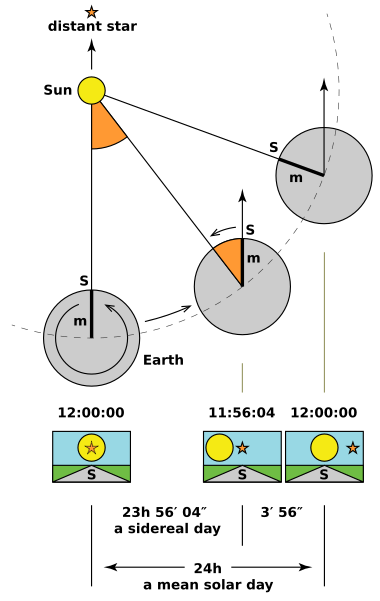Sidereal day facts for kids

Sidereal time (as a unit also sidereal day or sidereal rotation period) is a time-keeping system. It is used by astronomers to find celestial objects. Using sidereal time it is possible to point a telescope to the proper coordinates in the night sky.
Sidereal time is a "time scale based on Earth's rate of rotation measured relative to the fixed stars".
Because the Earth moves in its orbit about the Sun, a mean solar day is about four minutes longer than a sidereal day. Thus, a star appears to rise four minutes earlier each night, compared to solar time. Different stars are visible at different times of the year.
By contrast, solar time is reckoned by the movement of the Earth from the perspective of the Sun. An average solar day (24 hours) is longer than a sidereal day (23 hours, 56 minutes, 4 seconds) because of the amount the Earth moves each day in its orbit around the Sun.
Comparison to solar time

Earth makes one rotation around its axis in a sidereal day; during that time it moves a short distance (about 1°) along its orbit around the Sun. So after a sidereal day has passed, Earth still needs to rotate slightly more before the Sun reaches local noon according to solar time. A mean solar day is, therefore, nearly 4 minutes longer than a sidereal day.
The stars are so far away that Earth's movement along its orbit makes nearly no difference to their apparent direction (except for the nearest if having high accuracy, see parallax), and so they return to their highest point in a sidereal day.
Another way to see this difference is to notice that, relative to the stars, as viewed from Earth, the Sun appears to move around Earth once per year. A year has around 365.24 solar days but 366.24 sidereal days.
Sidereal days compared to solar days on other planets
All the solar planets more distant from the Sun than Earth are similar to Earth in that, since they experience many rotations per revolution around the Sun, there is only a small difference between the length of the sidereal day and that of the solar day – the ratio of the former to the latter never being less than Earth's ratio of 0.997. But the situation is quite different for Mercury and Venus. Mercury's sidereal day is about two-thirds of its orbital period, so by the prograde formula its solar day lasts for two revolutions around the Sun – three times as long as its sidereal day. Venus rotates retrograde with a sidereal day lasting about 243.0 Earth days, or about 1.08 times its orbital period of 224.7 Earth days; hence by the retrograde formula its solar day is about 116.8 Earth days, and it has about 1.9 solar days per orbital period.

